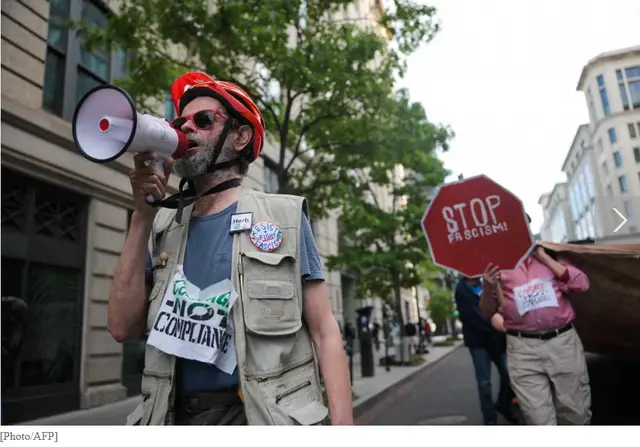Tens of thousands of demonstrators took to the streets under the banner "May Day Strong" in Washington DC and cities across all 50 states on Thursday, marking May 1 with widespread protests against the second-term policies of US President Donald Trump's administration.
In the nation's capital, demonstrators gathered at Franklin Square near federal buildings and marched to Lafayette Square at the gate of the White House, chanting slogans like "We Are the Majority, They Are the Minority" and "No Justice, No Peace", and waving handmade signs.
Messages ranged from "Protect Medicaid and Social Security" to calls for union protections and immigrant rights, reflecting the diverse coalition mobilized by the 50501 movement since its emergence from online forums earlier this year.
The number 50501, symbolizing "50 states, 50 protests, 1 movement", as a decentralized grassroots movement, largely organized the "National Day of Solidarity" protest across the US, mostly on May Day.
The protest events, right after the administration's first 100 days, merged traditional International Workers' Day themes with opposition to the second Trump administration's actions on immigration, federal agencies, social programs and perceived threats to democratic norms.
Many participants, like "DH", a protester from Northern Virginia who asked to be identified only by his initials, described their presence as a defense of fundamental rights. He emphasized concerns over "wealth inequality, protection of democracy and the people's right to speak their voice, no matter what".
DH, who is a teacher, specifically connected the May Day protest to the historical struggle for labor rights. "Part of the Trump administration is very anti-labor union, and the unions are what gave us weekends and holidays and benefits, protected people from child labor, protected people from having an unsafe workplace," DH told China Daily. He said that the labor unions are one of the few remaining groups in society that can push back.
"I think that the greatest notion is [against having] more than 1 percent of the population control 99 percent of the wealth in America," he said. "It is nice to see that everybody's rallying around that."
Immigration policies were among the major focal points.
Michelle Petrie, a retail worker participating in the demonstrations, criticized "the cruel treatment of people who've come to live in this country from other countries". She carried a butterfly model, explaining its significance to China Daily.
"May Day is International Workers Day. ... And the butterfly symbolizes, like, freedom," she said. "Also, this kind of butterfly is a monarch that migrates. ... And so, it's a sign of those things: immigration, beauty, freedom."
Petrie said the economy is "in the toilet" and predicted growing public anger.
Betty Lee Hawks, a retired 35-year federal employee who worked at the Department of Health and Human Services and the National Institutes of Health, told China Daily that she was concerned about the functioning of the federal government itself and the impact of policy changes on specific communities. Hawks specifically criticized efforts to dismantle diversity, equity and inclusion (DEI) initiatives.
"What gets rolled under that umbrella is decades of work to deal with health disparities," she said, explaining that the work addressed differences "in the incidence of disease and how people access services".
Hawks noted that historically, research data, particularly from clinical trials, skewed heavily toward white males, leaving gaps in understanding health outcomes for women and racial and ethnic minorities.
Efforts since the 1990s to include these groups were vital, she said, because "when you raise the health status of people who have historically been disadvantaged, you actually bring up everyone's health".
Hawks accused the administration of undermining this progress, citing staffing reductions at her former Office of Minority Health within HHS and actions impacting the National Institute on Minority Health and Health Disparities at NIH. "That is not an executive power. It's really up to Congress," she said.
Hawks also disputed the administration's economic claims, including tariffs. She added that immigrant labor played a vital role in the US economy.
The 50501 movement, leveraging social media platforms like Reddit, Instagram and TikTok, coordinated more than 1,000 events nationwide, according to its website.
The information from its website also showed that while Washington served as a central hub, actions varied widely, from traditional marches in New York and Seattle to community service projects like food drives in Southern California, aimed at supporting those affected by recent wildfires and economic hardships, attributed partly to the administration's tariff policies.
chinadaily
 简体中文
简体中文

